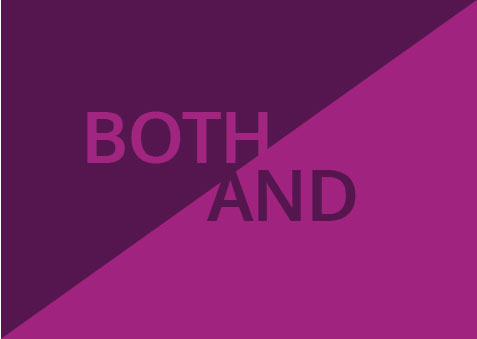November 6, 2018
Taking a “Both/And” View

I saw the best tattoo while out for breakfast the other day. I actually don’t have any tattoos, but have always thought if I got one, it would be a script tattoo because I love words, fonts and visual reminders. This one simply read: ‘both/and’ and it really spoke to me.
So often, especially now, it seems we are pulled to live in a binary world — things, people, places, opportunities, opinions are either good or bad, right or wrong, racist or non-racist, etc.
Earlier this year, I had the opportunity to hear Robin DiAngelo speak at the Seattle Public Library on her book, White Fragility: Why It’s So Hard for White People to Talk about Racism. I highly recommend you listen to her talk, “I think you’re a racist, I think I am too,” as she is very funny, and her work is accessible, incredibly relevant, and critical to the conversation on race, privilege, and oppression. It helped me understand why, white people like me, are so inclined to reduce conversations about racism to an individual assessment of whether we, or those around us, are either racist or not racist. In our desire to feel OK about the privilege we enjoy as a result of being white, DiAngelo explained, we must quickly come to the conclusion that we are NOT racist. DiAngelo further noted that keeping it personal allows us to ignore the fact that we live in a system that was intentionally designed to protect the profit and comfort of white people.
She also reminded us several times there is NO way at all that any of us could avoid being socialized with racist beliefs while growing up in this system. So, even if we decide that we are not racist, it is impossible not to be at some level, given the simple fact that we live in and benefit from our race-based society. Yet, it can be both/and. We can be both people who care deeply about racial justice, inclusion, diversity, and equity, and people who are still part of and support a system that is set up to benefit white people over people of color.
Another great both/and example was seen in the Seattle Art Museum’s recent Edward Curtis: Double Exposure art exhibit. I’ve been familiar with Edward Curtis’ art for years, and believed that his highly regarded photos helped expand the awareness of Native Peoples and Native culture. And, they did, but they also contributed to negative, harmful perceptions of Native Peoples, that linger today. The exhibit revealed how Curtis put props and costumes in his pictures that didn’t necessarily belong to the person whose photo he was taking. He also placed people in settings and poses that were not true to their identities.
In 1914, Curtis made the first feature film using all Native actors. And, even though he used cultural experts to inform the film’s accuracy, he spun a sensational tale of love, revenge, warfare and witchcraft — not in keeping with the cultural traditions that were represented. The film, called In the Land of the Headhunters, both brought attention to the existence of Native communities, while creating lasting, negative, oppressive stereotypes.
The Double Exposure exhibit also included the works of three contemporary Native artists—Will Wilson, Marianne Nicolson, and Tracy Rector—in an effort to counter the negative perceptions painted by Curtis’ work, and to create a new narrative on Native People. I was especially taken with Will Wilson’s amazing ‘talking’ portraits that invited you via your cell phone to hear the words of contemporary Native artists, and community members. Using the same tintype process of Curtis’ era, Wilson’s art paints both a century-old, mirror-like and completely modern story of Native People.
All of this brings me back to the wisdom of Bryan Stevenson, which I wrote about in “My Year of Waking Up” blog series earlier this year. Stevenson encouraged us to get close to those who are oppressed to be a witness, to get comfortable being uncomfortable (in conversations about race, in facing our own part in oppression) and to create a new narrative by listening deeply. I think taking a ‘both/and’ view is a start. For me, this means understanding that I can both care deeply about racism, structural injustice, and racial inequities, and I must recognize the ways that my socialization in a race-based system (from which I benefit from every day) contributes to the very oppression I hope to diminish.
How and where are you taking a both/and view?




